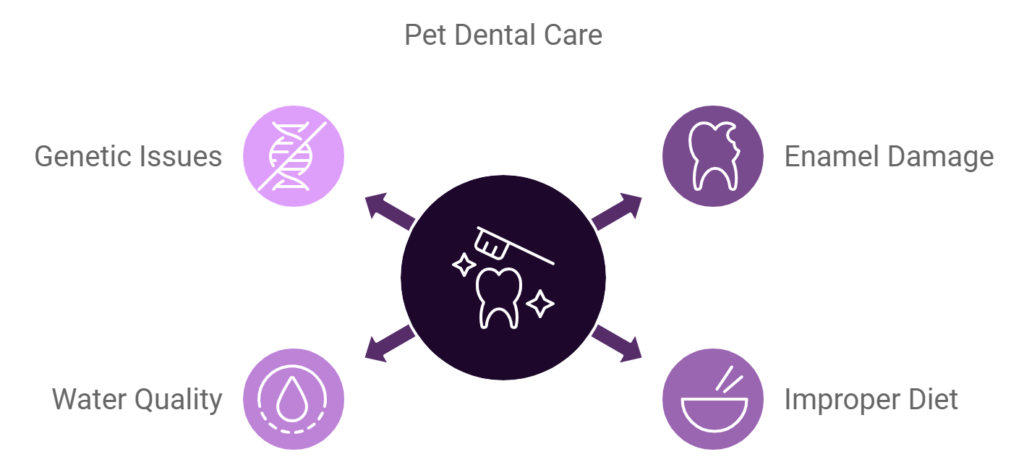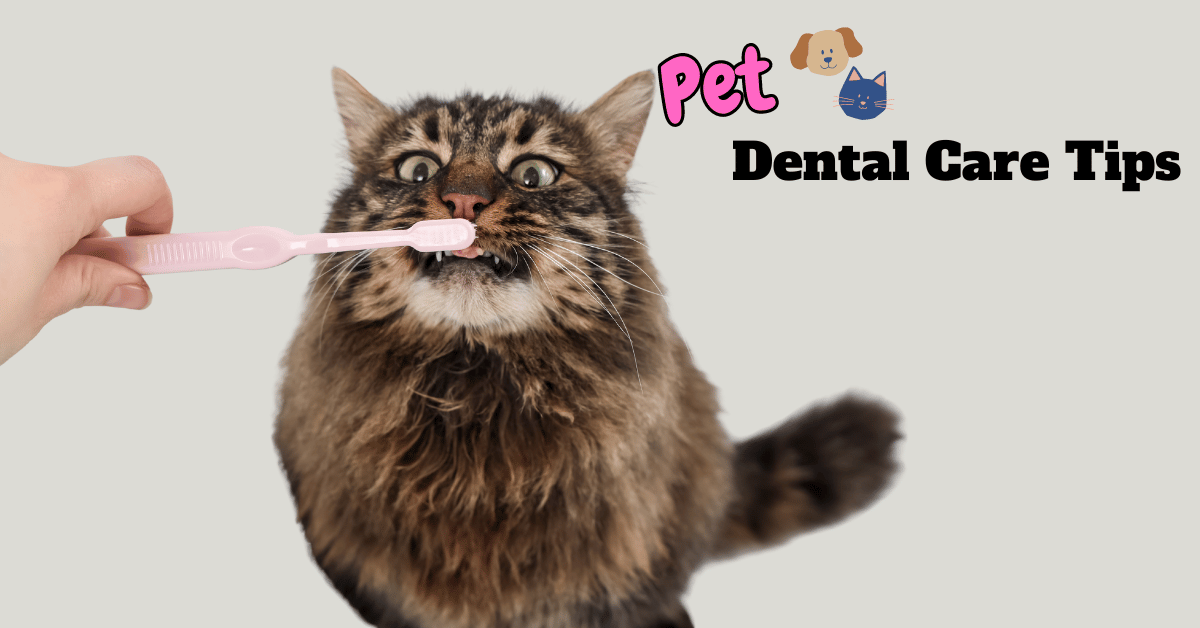Why Pet Dental Care Tips Matter
Proper care for your furry companion goes beyond balanced food, walks, and useful toys. The health of your pet is just as important as human health. This is especially true in the field of dentistry, as not all dog and cat owners realize the importance of preventive measures to avoid dental and gum diseases.
Here’s what a specialist in dentistry, a vet in Dubai, Dr. Andy Dellert, advised regarding dental care for dogs and cats: “I recommend scheduling a dental cleaning appointment when you notice bad breath and clear signs of discomfort in the oral cavity.”
Let’s explore modern dental care methods that will help your pets avoid serious health issues in the future.
Why Do Dogs and Cats Develop Dental Diseases?
Unlike us humans, our “little brothers” cannot fully take care of their teeth. This honorable mission falls on caring owners who must know and understand the basic principles of dental care. So why, despite all efforts, do pets still experience oral problems? Here are a few reasons:

- Enamel damage, chips, and cracks due to chewing on hard objects, sharp bones, playing with sticks, stones, and other items.
- Improper diet. A lack of essential nutrients can lead to inflammation, loose teeth, and other dental pathologies.
- Poor water quality or limited access to clean water.
- Genetic predisposition, such as malocclusion.
Your pets require regular care, as healthy teeth are the key to a happy and healthy animal!
Common Oral Cavity Pathologies
As they say, you need to know your enemy! Learn about the dental diseases that are frequently found in cats and dogs:
- Caries on the enamel and plaque, which can vary in color.
- Tartar. Harder than plaque, it often causes painful sensations in the gums.
- Stomatitis, an inflammation of the mucous membranes.
- Pulpitis and periodontitis are very serious conditions that require surgical intervention by a veterinarian. They are characterized by severe pain, bleeding, and other unpleasant symptoms.
As you can see, oral diseases in your pets are no different from those in humans. Your beloved “furries” also need help to relieve pain and suffering. But wouldn’t it be better not to let it get to that point?
How Do I Know if My Pet Has Dental Problems?
If you’re attentive to your pet’s behavior and its reaction to external stimuli, you’ll easily notice changes that might raise your concern.
How does a person behave when they have a toothache? The same goes for cats and dogs. Pets may unexpectedly and for no apparent reason show aggression toward innocent actions by their owner—such as attempts to pet, cuddle, play, or pick them up.
- While feeding, you may notice that your pet tries to eat on one side, leaves food in the bowl, or, worse yet, completely refuses their favorite food.
- Trying to alleviate the pain, the pet might whimper plaintively, constantly rubbing against corners and hard surfaces.
- Pets with dental pain may also drink less water than usual. A noticeable decrease in water consumption can exacerbate dental conditions, leading to further complications.
If you observe this behavior, immediately take your pet to the veterinary clinic—don’t let them suffer any longer!
One cat owner shared her experience after visiting the vet: “We thought he was grumpy and didn’t like affection. It turned out he had a toothache!”
What Does Dental Disease Prevention Consist Of?
To avoid the stress of sudden trips to the vet, it’s best to focus on prevention. This involves a range of measures that will help you maintain your pet’s health in the long run and save money.
Nutrition
Regular, balanced nutrition supplies the body with beneficial substances, including those essential for dental health. Ask your veterinarian how and what to feed your dog or cat—you might be surprised at how different your pet’s diet needs to be compared to a human diet!
Take note of these tips to help maintain your pet’s dental health every day:
- If you’re not using specialized balanced pet food, occasionally provide your cat or dog with vitamin and mineral supplements recommended by your veterinarian.
- Ensure your pet has access to plenty of clean, quality water. The water bowl should be placed in an easily accessible spot so your pet can drink whenever needed.
- In addition to regular water, consider incorporating dental water additives into their daily routine. These additives are designed to help reduce plaque buildup and freshen breath, offering a simple yet effective way to boost your pet’s oral health.
- Don’t overlook so-called dental diets (prescribed by a veterinarian). These foods have a special composition designed to prevent and remove plaque.
Pet food manufacturers have created a great alternative to combat plaque—chewing treats. These can be sticks, bones, or chew toys in various shapes and sizes, but not all are equally effective. Before buying such treats for your pet, be sure to consult with your veterinarian!
Regular Dental Checkups
Here’s an interesting fact: a healthy cat should have 30 teeth, with 14 on the lower jaw and 16 on the upper jaw. For dogs, it’s a bit different—they have more teeth, sometimes up to 42! There should be 20 on the upper jaw and 22 on the lower jaw.
Of course, there’s no need to perform a dental checkup every day, as it’s not the most pleasant procedure for your pet. What’s important is regularity, such as once every two weeks or as recommended by your veterinarian.
Take a look at this table, which will help guide you during checkups. It contains general information that may vary slightly depending on the breed.
| Norm | Norm (Cats) | Norm (Dogs) | Deviation (Cats) | Deviation (Dogs) |
Enamel color | White | White, cream, or slightly yellowish | Yellowish, beige | Dark yellow shades, brown |
| Condition of teeth | Clean, smooth surface | Same | Chips, cracks, dark spots, tartar | Same |
| Gums | Pink | Pale pink or pink | Darkening, areas of inflammation | Same |
| Breath | Present right after feeding | No | Present throughout the day | Same |
| Pain with light pressure | No | No | Present | Present |
Proper Teeth Cleaning
Regular teeth cleaning helps prevent or at least delay the onset of serious diseases that can cause suffering to your pet. There is a whole arsenal of pastes, gels, and toothbrushes designed specifically for pets, which are different from the ones we are used to.
It would be a big mistake to clean a dog’s or cat’s teeth with “human” toothpaste, as it may contain components that could cause allergies or poisoning. It’s important that the taste of the toothpaste is appealing to your pet, as they will be more willing to undergo the procedure.
Start getting your pet accustomed to the process from a young age. Initially, you can use your fingers wrapped in a soft cloth soaked in broth. Once your pet gets used to the movements, switch to a toothbrush. Use gentle, downward motions to clean the incisors and canines at the front of the jaw, gradually moving to the teeth in the back.
Once the pet is accustomed to the process, you should clean their teeth three times a week, or as recommended by your veterinarian.
Final Thoughts on Pet Dental Care Tips: Why Vet Visits Matter
While vet visits may not be the most pleasant experience for pets (think of your own visits to the dentist!), they are essential. Schedule a vet clinic visit in advance — dental specialists recommend bringing dogs and cats in for an examination once a year or more frequently if you notice serious issues.
During a routine check-up, the vet will thoroughly examine the oral cavity and, if necessary, perform a comprehensive diagnosis and treatment that may include several stages, such as:
- Professional cleaning of plaque and tartar using an ultrasonic scaler, followed by polishing.
- Full X-ray of the lower and upper jaws.
- Periodontal examination.
- Development of a detailed treatment plan.
During the examination, a biopsy may be needed if the vet identifies unusual tumor-like growths. Most of the examination and treatment will be done under anesthesia, so your pet won’t experience pain or discomfort.
A key part of vet visits is the consultation. Don’t hesitate to ask the specialist any questions—the more you know, the healthier and happier your pet will be!
Meet Sean, a fintech whiz with a penchant for pet purrs and blockchain buzz. After a decade of fintech feats, Sean’s tech talents leaped from ledger lines to litter lines, driven by a passion for pets and a vision for a more connected pet care community. With three critter companions as co-pilots, Sean launched this blog to share a treasury of pet-friendly tech tips and tales.


